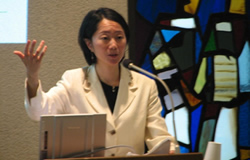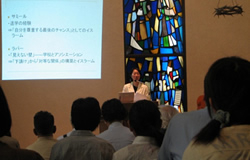Center for Interdisciplinary Study of Monotheistic Religions(CISMOR)Doshisha University
> Public Lectures > The Issues of Islam among Youth of Immigrant Origins in French SuburbsPublic Lectures
Project 2: Public Lecture
The Issues of Islam among Youth of Immigrant Origins in French Suburbs
| Date: |
2009/06/27 13:30 - 15:00 |
|---|---|
| Place: | Divinity Hall Chapel, Doshisha University |
| Lecture: | Chikako Mori (Associate Professor, Faculty of Foreign Studies, Nanzan University) |
| Summary: | |
|
After World War II, legions of immigrants settled in Europe, where they provided cheap labor. Many were Muslims, who are estimated to now number 150 million in the EU as a whole. France has the largest Muslim population in the EU. In the last 20 years, there has been friction between the Muslims and French society at every turn, and the Muslim presence is seen as problematic. The Muslims in such debates are represented by the young, male Muslims who live in the socially- and economically-marginalized, destitute suburbs with parents who are typically from North Africa. Our speaker today clarified what sort of Muslim consciousness the young people living in these poor suburbs have and how that consciousness is forged through their daily experience. As is the case in other areas, young Muslims living in the suburbs have diversity in their working and educational circumstances, and there is also a range of religious practices. Nonetheless, the thing they share is self-awareness of belonging to Islam and an identity as a Muslim. The period from 15 to 20 years of age is particularly important to the formation of this self-consciousness as a Muslim, or the time from the end of middle school until their high school years. The case studies collected during the speaker’s fieldwork make clear that the negative experiences of French high school life affect identity formation as a Muslim. In the case of one male student, the boy hoped for a better work environment than the manual labor in which his parents engaged, but due to his poor academic ability, he could not go on to a normal high school and was resigned to attending a vocational school. Yet going to the vocational school would mean that his future would be decided, and he would become a manual laborer. In terms of the system, the choice between a normal high school and a vocational school is decided solely by academic performance, but in practice, Caucasians generally go on to normal high school while the children of immigrants go on to vocational school. This results in a situation called “apartheid within the school.” To correct this difference between schools, the French government established integrated high schools that have a normal course and a vocational course on the same campus, but this only made the ethnic divide between the white students’ normal course and the immigrant children’s vocational course more visible. Due to this, immigrant children came to internalize the logic that the disparity in educational advancement corresponded to ethnic categories, and they tend to eventually drop out of regular society. There are some young people from the suburbs who go from a normal high school on to an institution of higher education, but when they face difficulties at each stage of their life, they recall their experience of ethnic discrimination. Many understand this to derive from their ethnic origin. Private Muslim associations act as a receptacle for the experiences of such suburban youth. In these associations, Islam is introduced not as a popular religion that their poor North African immigrant parents practice but as a “cool religion” of the well-educated and wealthy classes of the Near East, as exemplified by the Islamic scholar Tariq Ramadan. This experience allows them to fulfill academic desires that they could not have under the existing educational conditions. These groups invite young people to an authoritative Islam that can rank equal to Western civilization, or even surpass it. In this way, a negative self-image as a Maghreb immigrant shifts to a positive identity as a Muslim. Public schools should function to unify society, but in reality, they create educational disparity, and by excluding the poor, they instead become a place that breeds a value system opposed to everyday society. It is often argued that the Muslim presence threatens French values, but it can be said that the public schools actually turn suburban youth to Islam. Kiyoshi UEHARA CISMOR Research Assistan |
|
|
Handout |
|

